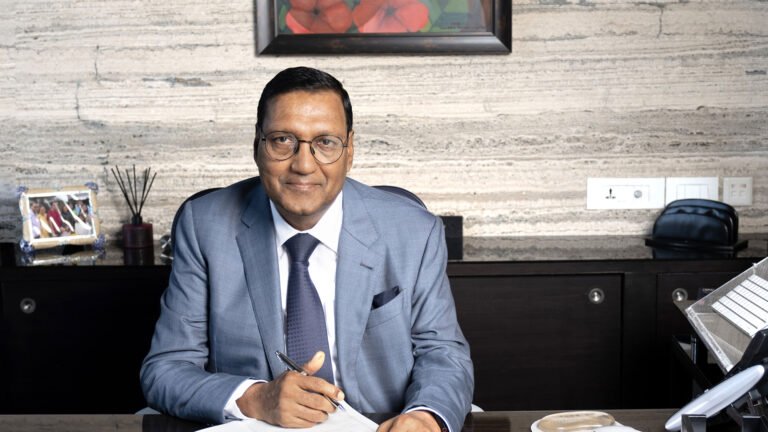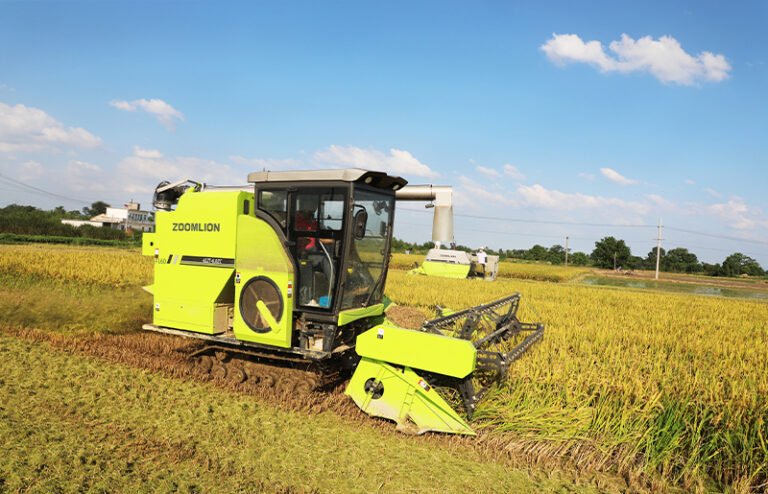From a humble beginning in 1988, BKT has grown in leaps and bounds to become one of the most recognizable industrial and agricultural tire manufacturer in the world.
Chairman and Managing Director Arvind Poddar, talks about the company’s journey since inception.
Mr. Poddar, can you tell us something about the history of BKT and whose idea was to enter the tire, and more specifically the Off-Highway Tire business?
BKT’s journey began in 1988 in Aurangabad, Western India, when my father, Late Mr. Mahabirprasad Poddar, and my elder brother, Late Mr. Suresh Poddar, established the company to produce 2-3-wheeler tires for the Indian market. In 1991, we were joined by another family member, Late Mr. Pramod Poddar, my first cousin, further strengthening our team with his valuable expertise.
As the 2-3 wheelers market became increasingly crowded, Mr. Pramod Poddar recognized a promising opportunity in the international Off-Highway Tire (OHT) business. As a forward-thinking family, we made the strategic decision to gradually shift our focus from 2-3 wheelers and concentrate on the OHT business. Following our initial success, we expanded our production capacity by establishing another plant in Bhiwadi, Northern India, ensuring consistent supplies to meet growing demands. However, during the first decade, our growth was limited as we focused on establishing our products in the market.
At the closing of our fiscal Year 2006-2007, our turnover was Euro 84 million (at today’s exchange rate). In 2007, we started a transformative path, outlining a comprehensive new strategy that emphasized product quality and brand building. This dedicated approach propelled us to cross the remarkable milestone of Euro 1 billion turnover in 2022, consolidating our position as an exceptional force in the industry.
This achievement is a testament to the unwavering commitment of our team and the visionary leadership of Late Mr. Mahabirprasad Poddar, Late Mr. Suresh Poddar, and Late Mr. Pramod Poddar. Moving forward, we remain focused on pushing the boundaries of innovation, delivering superior quality products, and marking a path of sustained growth and success.
Today, our journey has led us to a remarkable growth and numerous milestones. We take pride in operating four state-of-the-art tire manufacturing plants, equipped with advanced technologies, alongside a dedicated and fully equipped research and development center that includes an in-house testing track. This infrastructure empowers us to continuously innovate and deliver cutting-edge solutions. BKT’s influence extends across all segments of the Off-Highway tire business, catering to diverse industries and applications. With an extensive portfolio comprising over 3200 SKUs, we offer the widest range of specialized tires in these sectors. This range of products enables us to meet the unique needs and demands of our customers, reaffirming our position as a leading provider in the Off-Highway tire market.
Do you have any other brand or association with any other company?
No, we have only BKT brand. As a company, we maintain a singular focus on our own brand and do not have any direct or indirect associations with any other company or brand. Our dedication lies solely in building and promoting the BKT brand, ensuring that it represents our values, quality, and commitment to excellence. By maintaining this exclusivity, we can channel all our efforts and resources into continuously enhancing and expanding the BKT brand’s presence in the market, without any distractions or dilution of our identity.
Mr. Poddar, transparency towards stakeholders is one of the pillars that distinguishes your history: is this where your undisputed leadership stems from?
We are extremely proud of the success that BKT has achieved as an international brand in the Off-Highway tire sector, thanks to a series of distinctive characteristics. Among these, sound financial management undoubtedly represents one of the factors that have allowed us to achieve this goal, giving us the opportunity to constantly invest in comprehensive growth and technological innovation.
This is further demonstrated by the recent opening of the Bhuj factory to over 100 journalists from around the world, which serves as a clear example of our transparency and consistency in everything we assert, ready to engage in discussions and follow through on every statement.
How can a multinational corporation as large as yours be close to people? What value do you attribute to Corporate Social Responsibility?
The corporate culture of BKT represents our DNA and guides every activity and strategic decision, providing us with an ethical compass that directs us towards achieving our goals. We create a motivating and engaging work environment for all our employees because we recognize that each individual is an integral part of the company’s success. Furthermore, we are strongly committed to reducing the environmental impact of our production activities and improving the health and safety of our employees.
To accomplish this, we have implemented a series of sustainable company policies and practices, including the use of renewable energy in our factories and the reduction of CO2 emissions.
We firmly believe that sustainability is a significant social responsibility for every company, and we are dedicated to doing our part to contribute to a better future for our planet. Additionally, we are actively working on developing increasingly sustainable tires that can deliver high performance without compromising the environment. Sustainability is a fundamental component of our company mission, and we will continue to invest in innovative solutions to foster a greener and more sustainable world.
So, what is the key to the success of a brand like yours? How do you manage to maintain such a strong presence worldwide for such a long time?
BKT is a successful brand in the Off-Highway tire industry, also thanks to its strong global presence in the OEM channel as well as in the aftermarket where we deal with partner distributors in more than 160 countries. This extensive market coverage, combined with the quality of our products and services, has allowed us to earn a reputation par excellence in the industry.
Our effective and transparent communication with our customers further supports this reputation. While there are other indian brands claiming to have the same quality as our products, the facts demonstrate that BKT is truly unique. We are confident that our end customers and tire dealers working with the BKT range recognize our superiority in terms of quality and performance, which speak for themselves. The loyalty of our customers and their choice to rely on us for their Off-Highway tire needs are a testament to our success.
The mere geographical origin of a company does not inherently bestow identical product quality or ensure quick results, as some brands may seek to insinuate or attain. The ascendance of any brand, including BKT, requires years of unwavering dedication, resolute efforts, and commitment to excellence.
We persistently strive to expand our portfolio, not only in terms of product with the superior quality, but also in the breadth and enduring nature of our offerings. Our pursuit to excellence knows no bounds as we continually endeavor to surpass previous benchmarks and elevate our industry standards.
Some newer brands claim that their quality is same as BKT and prices much cheaper. How do you react to this?
To manufacture a tire of utmost quality, meticulous attention to every facet of its creation is required, beginning with the sourcing of superior raw materials, the establishment of state-of-the-art production infrastructure, and the implementation of stringent in-process quality checks. Furthermore, an exceptional team of skilled individuals plays an indispensable role in the pursuit of tire manufacturing excellence. Considering the above, it becomes evident that providing to the market such an equivalent quality level, but at a lower price, is not a sustainable proposition, for it would mean compromising on these crucial elements that contribute to the unparalleled quality and performance of our products.
How can one be certain of their competitive advantage, especially in a rapidly changing market?
To maintain a competitive advantage in an ever-evolving market, the quality of BKT products represents just one facet of our approach as a premium brand. Our dedication to innovation is a fundamental element that sets us apart from a myriad of other brands. However, we don’t merely offer high-quality products; we also strive to adopt superior marketing strategies.
Over the years, we have developed strategies that aim not only to raise awareness of the BKT brand but also to create an engaging experience for our customers. Through participation in trade fairs and industry events, advertising campaigns, sports sponsorships, and other targeted initiatives, we consistently position BKT as a leader in the industry and solidify our reputation.
Looking towards the future, we will continue to invest in research and development, cutting-edge technologies, and impactful marketing strategies. We are determined to continuously exceed our customers’ expectations and strengthen our leadership in the Off-Highway tire industry. Our goal is to provide a comprehensive solution that surpasses mere expectations, reaffirming our position as the undisputed benchmark in the field.
Does dominating a market sector mean having winning strategies or simply being the strongest? Have you ever considered creating sub-brands to secure a larger market share?
This question gives me the opportunity to address an important matter. We have heard rumors and learned through interviews about brands that, despite their best efforts, try to associate themselves with BKT without having any connection to us.
Throughout our journey, we have never felt the need to compare ourselves to others, not even in the distant past. We know who we are, our roots, and we have always been clear about our objectives, staying true to our path without deviations. With our unwavering resources, we have taken every necessary step, always looking ahead. When you are aware of your own identity, nature, and purpose, there is no need to look at others or, even worse, constantly mention them.
Our gentlemanly nature is reflected in our approach to the business world, as we always carry values of composure and responsibility. However, we do not tolerate the use of our brand as bait to attract attention or gain credibility that should be earned through concrete actions and demonstrating real value.
We firmly believe that the difference between them and us is significant and undeniable, both in terms of product quality, industry experience and knowledge. We will continue to focus on our mission of providing high-quality solutions to our customers, maintaining our position as an industry leader, and investing in research and development to constantly innovate our product range.
Also Read
Advantages Of “Cyclic Field Operations” For Both IF And VF Tires
State Of Tractor Sales In South Africa In The Month Of March

